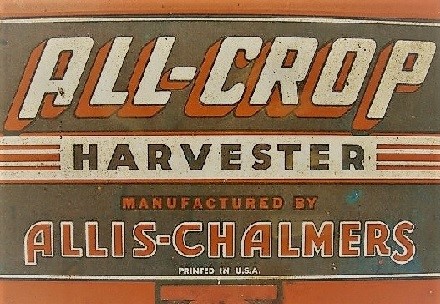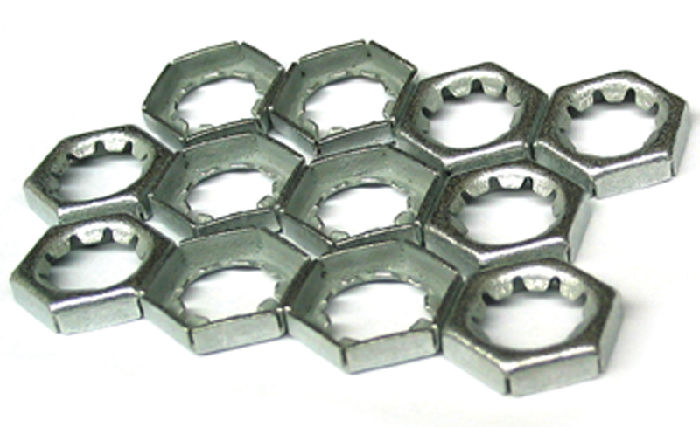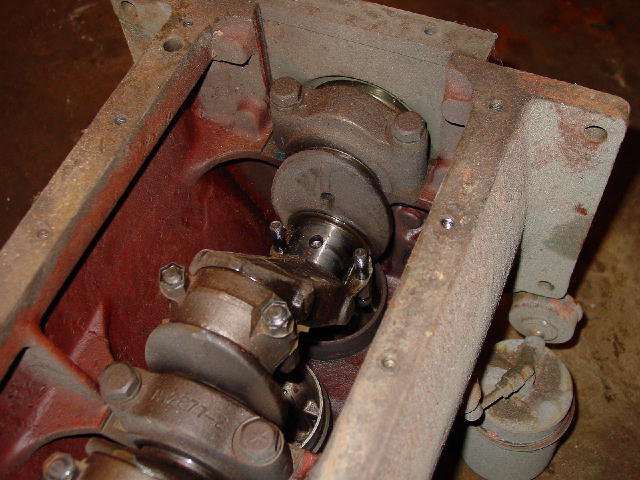| Author |
 Topic Search Topic Search  Topic Options Topic Options
|
CrestonM 
Orange Level


Joined: 08 Sep 2014
Location: Oklahoma
Points: 8455
|
 Post Options Post Options
 Thanks(0) Thanks(0)
 Quote Quote  Reply Reply
 Topic: Engine Bearing Cap Lock Method Question Topic: Engine Bearing Cap Lock Method Question
Posted: 12 Dec 2017 at 12:31pm |
This may be a dumb question, but how necessary are things like cotter pins/wire/lock nuts for an engine's bearing caps? For instance, on my 8N, all the bearing cap bolts have wire running through them, I guess as a safety measure to keep them from loosening? My B has nothing on the main bolts, but has cotter pins through castle nuts on the rod bolts. My 1951 Chevy has nothing on the main bolts, but has these flimsy stamped steel lock nuts on the rods. In fact, some were missing when I took the engine apart, and they weren't in the oil pan. I also found out, just barely tighten them, or they crush/strip out.
Maybe these things are more important than I'm thinking they are, but is a piece of wire or a flimsy stamped nut with no true threads going to really keep a bearing cap from coming loose? Is that their real purpose? Either way, I always put everything back like it was. Figure the engineers had something in mind. Thanks
|
 |
|
Sponsored Links
|
|
 |
Dick L 
Orange Level


Joined: 12 Sep 2009
Location: Edon Ohio
Points: 5087
|
 Post Options Post Options
 Thanks(0) Thanks(0)
 Quote Quote  Reply Reply
 Posted: 12 Dec 2017 at 1:20pm Posted: 12 Dec 2017 at 1:20pm |
|
I have taken a bunch of these engines apart and most but not all have the main cap bolts wired. I have never found any main cap bolts that were loose. I have always found the cotter keys in the rod cap nuts. I wouldn't put one back together without them. The stamped spring steel safety locks do work.
The way I have always done the B and C engine rod caps was to torque to 35 foot pounds and tighten only as much more it takes to get the cotter key in if necessary. I never had a loose nut failure this way.
Edited by Dick L - 12 Dec 2017 at 1:31pm
|
 |
CrestonM 
Orange Level


Joined: 08 Sep 2014
Location: Oklahoma
Points: 8455
|
 Post Options Post Options
 Thanks(0) Thanks(0)
 Quote Quote  Reply Reply
 Posted: 12 Dec 2017 at 2:18pm Posted: 12 Dec 2017 at 2:18pm |
Thanks, Dick! These are the stamped nuts I was talking about. Is that what you meant by the spring steel safety locks? 
|
 |
Dick L 
Orange Level


Joined: 12 Sep 2009
Location: Edon Ohio
Points: 5087
|
 Post Options Post Options
 Thanks(0) Thanks(0)
 Quote Quote  Reply Reply
 Posted: 12 Dec 2017 at 4:55pm Posted: 12 Dec 2017 at 4:55pm |
Yes. 
|
 |
DMiller 
Orange Level Access

Joined: 14 Sep 2009
Location: Hermann, Mo
Points: 33928
|
 Post Options Post Options
 Thanks(0) Thanks(0)
 Quote Quote  Reply Reply
 Posted: 12 Dec 2017 at 4:59pm Posted: 12 Dec 2017 at 4:59pm |
|
They are called "Pal Nuts" and are far from a locking device but were used for such on early engines where many of them ended up drained with oil changes. A LITTLE red or even LESS blue Loctite will hold as well if not better on the cap nuts.
|
 |
CTuckerNWIL 
Orange Level


Joined: 11 Sep 2009
Location: NW Illinois
Points: 22825
|
 Post Options Post Options
 Thanks(0) Thanks(0)
 Quote Quote  Reply Reply
 Posted: 12 Dec 2017 at 6:38pm Posted: 12 Dec 2017 at 6:38pm |
Working on machine tools for most of 15 years I always carried a roll of safety wire and the pliers for twisting it up. It came in real handy when putting my WC back together. I would never put a pan back on without something on each nut! 
|
|
|
 |
CrestonM 
Orange Level


Joined: 08 Sep 2014
Location: Oklahoma
Points: 8455
|
 Post Options Post Options
 Thanks(0) Thanks(0)
 Quote Quote  Reply Reply
 Posted: 12 Dec 2017 at 6:44pm Posted: 12 Dec 2017 at 6:44pm |
|
I've always put the correct wire/pin/pal nut wherever they are supposed to be, it's just a curiosity I've had, ever since I opened up my 1st engine project in 2014.
|
 |
ALLISMAN32 
Bronze Level


Joined: 13 Mar 2011
Location: Hillsboro, IN
Points: 199
|
 Post Options Post Options
 Thanks(0) Thanks(0)
 Quote Quote  Reply Reply
 Posted: 12 Dec 2017 at 7:20pm Posted: 12 Dec 2017 at 7:20pm |
|
I was wondering the same thing saturday evening assembling a continental n62 engine Creston! The mains bolts on it had the holes for lock wire. I went ahead and put the wire on them but I think if they were properly torqued they would never back out. Many of the other bolts on those older engines have no retainment device on them, i cant think of any automotive or agricultural engine that uses a locking wire or cotter pins In the last 50 years.
|
 |
Hubert (Ga)engine7 
Orange Level


Joined: 12 Sep 2009
Location: Jackson Cnty,GA
Points: 6465
|
 Post Options Post Options
 Thanks(0) Thanks(0)
 Quote Quote  Reply Reply
 Posted: 12 Dec 2017 at 8:32pm Posted: 12 Dec 2017 at 8:32pm |
[QUOTE=CTuckerNWIL]Working on machine tools for most of 15 years I always carried a roll of safety wire and the pliers for twisting it up. It came in real handy when putting my WC back together. I would never put a pan back on without something on each nut!  [/QUOTE
X2! After working on military aircraft for over 36 years I have used miles of lock (safety) wire and it is essential as are cotter pins for castellated nuts and there is a right way and wrong way to install the wire. The wire twister pliers Charlie pictured come in very handy but you can do the job with a good pair of duckbills and diagonal cutters. Good wire twisters are expensive (around $90) but the cheap ones from HF are junk and a waste of your money. Safety wire is s/s and comes in .020", .032", and .041" plus copper in .020".
|
|
Just an old country boy saved by the grace of God.
|
 |
MACK 
Orange Level

Joined: 17 Nov 2009
Points: 7664
|
 Post Options Post Options
 Thanks(0) Thanks(0)
 Quote Quote  Reply Reply
 Posted: 12 Dec 2017 at 9:04pm Posted: 12 Dec 2017 at 9:04pm |
|
If the bolt is properly tightened it will stay. If it is left loose, it will ware the safety wire out and come loose anyway. Old technology. MACK
|
 |
LeonR2013 
Orange Level


Joined: 01 Jan 2013
Location: Fulton, Mo
Points: 3500
|
 Post Options Post Options
 Thanks(0) Thanks(0)
 Quote Quote  Reply Reply
 Posted: 12 Dec 2017 at 11:39pm Posted: 12 Dec 2017 at 11:39pm |
|
Had you ever thought that these bolts are not torque to yield bolts? That's why some bolts torque to a certain point, and then you turn them the so many degrees. It also prevents a false torque.
|
 |
B26240 
Orange Level

Joined: 21 Nov 2009
Location: mn
Points: 3866
|
 Post Options Post Options
 Thanks(0) Thanks(0)
 Quote Quote  Reply Reply
 Posted: 13 Dec 2017 at 6:20am Posted: 13 Dec 2017 at 6:20am |
|
Some years ago I overhauled a WC and found one of the nuts on a rod bolt split (cracked) I think it happened when someone over tightened it to get it to the next wire slot to put safety wire in. That made me question tourquing to a certain spec but then going more if nessesary to get safety wire in. i still do it though as who knows how many times that nut had been off and reinstalled over the years.
|
 |
Allis dave 
Orange Level

Joined: 10 May 2012
Location: Northern IN
Points: 3043
|
 Post Options Post Options
 Thanks(0) Thanks(0)
 Quote Quote  Reply Reply
 Posted: 13 Dec 2017 at 7:01am Posted: 13 Dec 2017 at 7:01am |
|
Far from an expert, but the reason you don't see safety wire and cotter pins on todays engines, is new technology like MACK said. Now you have all sorts of lock nuts. Even the WD45 had a sort of lock nut instead of wire.
|
 |









 Topic Options
Topic Options


 Post Options
Post Options Thanks(0)
Thanks(0)









